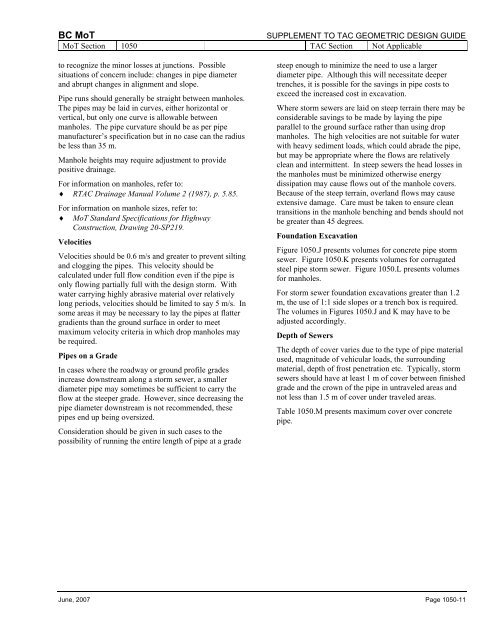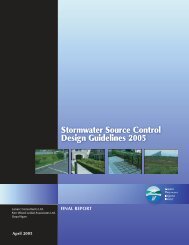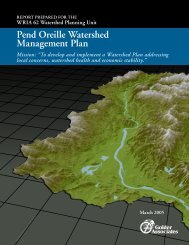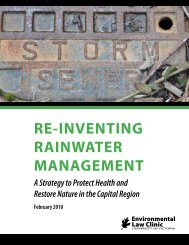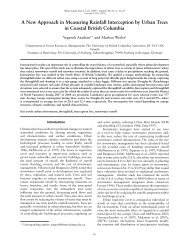1000 Hydraulics Chapter - Ministry of Transportation
1000 Hydraulics Chapter - Ministry of Transportation
1000 Hydraulics Chapter - Ministry of Transportation
Create successful ePaper yourself
Turn your PDF publications into a flip-book with our unique Google optimized e-Paper software.
BC MoT<br />
SUPPLEMENT TO TAC GEOMETRIC DESIGN GUIDE<br />
MoT Section 1050 TAC Section Not Applicable<br />
to recognize the minor losses at junctions. Possible<br />
situations <strong>of</strong> concern include: changes in pipe diameter<br />
and abrupt changes in alignment and slope.<br />
Pipe runs should generally be straight between manholes.<br />
The pipes may be laid in curves, either horizontal or<br />
vertical, but only one curve is allowable between<br />
manholes. The pipe curvature should be as per pipe<br />
manufacturer’s specification but in no case can the radius<br />
be less than 35 m.<br />
Manhole heights may require adjustment to provide<br />
positive drainage.<br />
For information on manholes, refer to:<br />
♦ RTAC Drainage Manual Volume 2 (1987), p. 5.85.<br />
For information on manhole sizes, refer to:<br />
♦ MoT Standard Specifications for Highway<br />
Construction, Drawing 20-SP219.<br />
Velocities<br />
Velocities should be 0.6 m/s and greater to prevent silting<br />
and clogging the pipes. This velocity should be<br />
calculated under full flow condition even if the pipe is<br />
only flowing partially full with the design storm. With<br />
water carrying highly abrasive material over relatively<br />
long periods, velocities should be limited to say 5 m/s. In<br />
some areas it may be necessary to lay the pipes at flatter<br />
gradients than the ground surface in order to meet<br />
maximum velocity criteria in which drop manholes may<br />
be required.<br />
Pipes on a Grade<br />
In cases where the roadway or ground pr<strong>of</strong>ile grades<br />
increase downstream along a storm sewer, a smaller<br />
diameter pipe may sometimes be sufficient to carry the<br />
flow at the steeper grade. However, since decreasing the<br />
pipe diameter downstream is not recommended, these<br />
pipes end up being oversized.<br />
Consideration should be given in such cases to the<br />
possibility <strong>of</strong> running the entire length <strong>of</strong> pipe at a grade<br />
steep enough to minimize the need to use a larger<br />
diameter pipe. Although this will necessitate deeper<br />
trenches, it is possible for the savings in pipe costs to<br />
exceed the increased cost in excavation.<br />
Where storm sewers are laid on steep terrain there may be<br />
considerable savings to be made by laying the pipe<br />
parallel to the ground surface rather than using drop<br />
manholes. The high velocities are not suitable for water<br />
with heavy sediment loads, which could abrade the pipe,<br />
but may be appropriate where the flows are relatively<br />
clean and intermittent. In steep sewers the head losses in<br />
the manholes must be minimized otherwise energy<br />
dissipation may cause flows out <strong>of</strong> the manhole covers.<br />
Because <strong>of</strong> the steep terrain, overland flows may cause<br />
extensive damage. Care must be taken to ensure clean<br />
transitions in the manhole benching and bends should not<br />
be greater than 45 degrees.<br />
Foundation Excavation<br />
Figure 1050.J presents volumes for concrete pipe storm<br />
sewer. Figure 1050.K presents volumes for corrugated<br />
steel pipe storm sewer. Figure 1050.L presents volumes<br />
for manholes.<br />
For storm sewer foundation excavations greater than 1.2<br />
m, the use <strong>of</strong> 1:1 side slopes or a trench box is required.<br />
The volumes in Figures 1050.J and K may have to be<br />
adjusted accordingly.<br />
Depth <strong>of</strong> Sewers<br />
The depth <strong>of</strong> cover varies due to the type <strong>of</strong> pipe material<br />
used, magnitude <strong>of</strong> vehicular loads, the surrounding<br />
material, depth <strong>of</strong> frost penetration etc. Typically, storm<br />
sewers should have at least 1 m <strong>of</strong> cover between finished<br />
grade and the crown <strong>of</strong> the pipe in untraveled areas and<br />
not less than 1.5 m <strong>of</strong> cover under traveled areas.<br />
Table 1050.M presents maximum cover over concrete<br />
pipe.<br />
June, 2007 Page 1050-11


